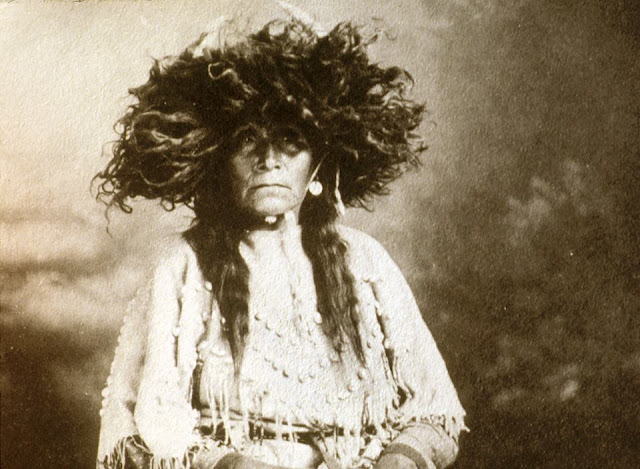Horned Women series III: Snake Woman of the (women's) Motokiks ceremonial society, Kainai Nation ("Blood," a branch of the Siksika or Blackfeet), somewhere in Montana or Alberta. She is a pipeholder, wearing the Scabby Buffalo headdress. [courtesy women's repressed histories]
Saturday, July 13, 2013
Monday, July 1, 2013
lakulisha kundalini yoga...
i was discussing with my friends that i've been spending a lot of time in ecstatic movement, playing with gesture and posture as a conduit for generating and discharging energy, and the effect its having on me and i was gifted this information, for which i'm very grateful.
(fr Words Fr the Soul) According to the Pashupata Sutra and the Ganakarika Sutra (Collins, 1988, p. 137-38), the Lakulisha kundalini yoga sect practiced an ecstatic ritual including wild laughter, sacred singing, "dancing consisting of [all possible] motions of the hands and feet: upward, downward, inward, outward and shaking motion," a sacred "sound produced by the contact of the tongue-tip with the palate...after the dance when the devotee has again sat down and is still meditating on Siva" an "inner worship," and “prayer” (p. 137).
I suggest that such dancing and singing were sahaja or charismatic manifestations and not ordinary volitional merriment that were later codified from shrutis (in-the- moment revelatory utterances) into smritis (remembered scripture), formalized from sahaja manifestations into standardized asanas and the myriad prescribed and detailed gestures of certain classicalized Indian dance forms.
The Pashupata sect spread massively throughout Hindu, Buddhist and Jain India for some 600 years, producing one of the greatest outpourings of temple construction in human history. The sect was noteworthy in Indian history in its scorn of rigidification and other corruptions of the otherwise, moderately fluid caste (varna, “human variance”) system and its belief in a deity capable of bestowing redemptive grace beyond the causal dictates of karma.
Lakulisha and his followers believed (as did the original Franciscan cult) that, as forest-dwelling (“counter-cultural?”) kundalini yogis, they transformed the strife of city-dwellers by absorbing social ridicule or by receiving homage and bestowing shaktipat blessings upon the populace. Indeed, the prejudices of caste and other animosities evaporated during their shaktipat rituals that were attended to a remarkable degree by all levels of society. As with the appearance of many other saints throughout history, heaven lived on earth, and those within its fold were, for a time, redeemed into fully dharmic life.
i have found a modest place to start holding this kind of space and sound open for others as i do my own exploration and practice.
(fr Words Fr the Soul) According to the Pashupata Sutra and the Ganakarika Sutra (Collins, 1988, p. 137-38), the Lakulisha kundalini yoga sect practiced an ecstatic ritual including wild laughter, sacred singing, "dancing consisting of [all possible] motions of the hands and feet: upward, downward, inward, outward and shaking motion," a sacred "sound produced by the contact of the tongue-tip with the palate...after the dance when the devotee has again sat down and is still meditating on Siva" an "inner worship," and “prayer” (p. 137).
I suggest that such dancing and singing were sahaja or charismatic manifestations and not ordinary volitional merriment that were later codified from shrutis (in-the- moment revelatory utterances) into smritis (remembered scripture), formalized from sahaja manifestations into standardized asanas and the myriad prescribed and detailed gestures of certain classicalized Indian dance forms.
The Pashupata sect spread massively throughout Hindu, Buddhist and Jain India for some 600 years, producing one of the greatest outpourings of temple construction in human history. The sect was noteworthy in Indian history in its scorn of rigidification and other corruptions of the otherwise, moderately fluid caste (varna, “human variance”) system and its belief in a deity capable of bestowing redemptive grace beyond the causal dictates of karma.
Lakulisha and his followers believed (as did the original Franciscan cult) that, as forest-dwelling (“counter-cultural?”) kundalini yogis, they transformed the strife of city-dwellers by absorbing social ridicule or by receiving homage and bestowing shaktipat blessings upon the populace. Indeed, the prejudices of caste and other animosities evaporated during their shaktipat rituals that were attended to a remarkable degree by all levels of society. As with the appearance of many other saints throughout history, heaven lived on earth, and those within its fold were, for a time, redeemed into fully dharmic life.
i have found a modest place to start holding this kind of space and sound open for others as i do my own exploration and practice.
Subscribe to:
Posts (Atom)

